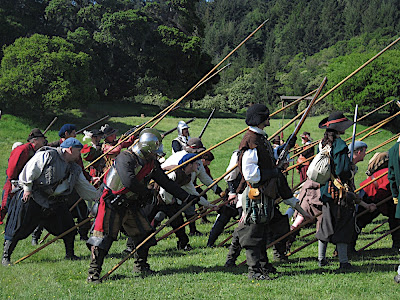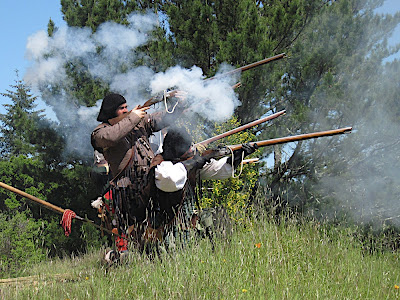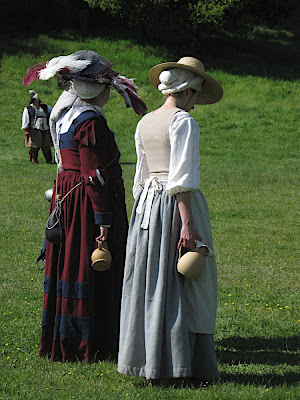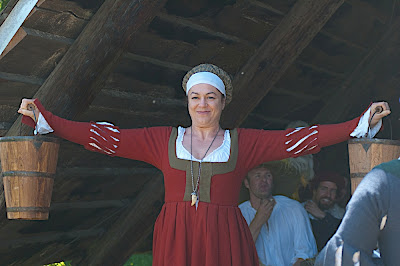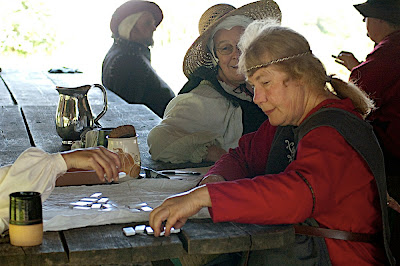
This blog entry may take a bit of time to fill in. Right now, the photos are all uploaded, but I need to work on the text. As usual, click on a slideshow if you want to go to the Picasa album. From there, you can access my other albums, too.
Arrival and Our First Day, March 22 and 23After landing at Narita Airport and taking a two or three hour bus ride, it was late (23:00?), and we were very tired. We met the Hiroses (our Tea sensei Yoshiko-san and her husband Kazukio-san) at Ikebukuro Station. We then took a train to Hoya Station and caught taxis to our respective lodgings. It was a good thing they were there to guide us, because our brains were fried, and no good for further naviation. Yoshiko-san took Harvey and Holly home with her, and Kazukio-san helped Kristin and me to Tatami Guesthouse. It is also known as Hibari House, which is possibly its old name that is still over the door. We tolerated a rather long introduction to the features of the guesthouse, took our room key, and promptly landed in bed.
Hibari House is very inexpensive long-term lodging. I think we paid a total of $700 for three weeks. It is bare-bones dormitory-style, with toilets and a trough sink down the hall. The small common room with kitchen, coin-op showers and laundry are on the first floor. Most tenants are college-age, and stay out late, often returning after midnight to have a loud conversation in the echoey hall before retiring for a noisy nightcap in their tissue-thin walled room. Even the hosts seemed oblivious to normal sleep patterns. One night, at 3:00, I had to yell at the otherwise thoughtful Mokoto-san, who was flinging recycling into a bin outside our window. The white noise application on my iPod got a workout every night. The money savings on the room was great, but was not worth the loss of sleep.
The next morning, Mokoto-san kindly gave us a street map of the western part of Tokyo, which supplemented the copies of Google Maps that I had brought. We easily made the ten minute walk to Hibarigaoke Station, got transportation passes, and hopped on the train to the next station at Hoya. Then we fumbled our way along toward the Hiroses' house, getting some friendly help from a shop keeper who spoke as much English as we did Japanese. Harvey and Holly met us along the main road, and guided us the rest of the way. This saved us from getting lost, because precious few Japanese streets actually have signs, or even names. I'm not sure there are any streets in Tokyo that actually run on a grid, so it is easy to get lost once one leaves the safety of a known street. I still haven't quite deciphered their district, block, street and house numbering system, and am not sure how anyone can find a house without a seasoned guide.
All in all, the trip from Hibari House to the Hiroses' home took us about 45 minutes, which on one hand was great for exercise, but on the other hand was annoyingly inconvenient, especially when we happened to be carrying lots of loot. ...Especially in the rain. ...At night. ...When it was often already way past my bedtime after a long day of running around.
On that first morning, we visited with Sensei for a while. She showed us her Tea room, and we helped get the sunken hearth ready for the summer season. In the afternoon the Hiroses' daughter, Yumiko-san, showed us around Kichijoji, a district where she has her massage studio. After seeing her cozy studio (with a wee garden), we went to a beautiful park called Inokashira-koen. The centerpiece of the park is a lake surrounded by sakura trees. I think that this is the park depicted in the German film "Hanami" (or "Cherry Blossoms" in American versions).
On a small island in the lake is a shrine to Benzaiten (a.k.a. Benten), the goddess of music and art. Yumiko-san told us that Benziaten is said to be jealous of couples who go boating on the lake, and will cause them to break up. There is also a small shrine on the island dedicated to a white snake (Ugajin) that protects the island. The sakura were barely beginning to bloom, but delicate white magnolias were blooming and maple leaves were opening. We began our birdwatching here, greedily spotting large-billed crows, bulbuls, great tits and other birds that enjoy the park.
In the evening, we met Yoshiko- and Kazukio-san at Kichijoji Station, and went out for a delicious dinner. As with most (if not all) train stations in Tokyo, Kichijoji Station has a large shopping mall with many enticing restaurants. I could have happily eaten my way through this station, and then moved on to the next. I should have followed Holly's example (learned from experience), to photograph my meals. Not only were they delicious, but even the simples noodle dish was lovely. I think I had fish for this this first dinner. Afterward, Kazukio-san made sure Kristin and I got onto the correct bus to a train station. The others took a cab home, in deference to the Hiroses' age. Then with help from some kind strangers Kristin & I got to Hibarogaoke Station, whence we retraced our steps to our room at Hibari House.
Our lodgings in Hibarigaoke and the Hiroses' home southeast of Hoya are approximately nine miles from Tokyo Harbor, and are out in the Tokyo suburbs. I had thought of Tokyo as being a huge crush of concrete and humanity, but found that the suburbs have room for modest gardens, and even sizable market gardens. Across from the Hiroses' home there is what appears to be a family farmhouse surrounded by a couple of acres of cabbages. On that first morning, we met one of these family members planting cabbages on another plot down the road. Eriko-san told us that her family farmed many plots in the neighborhood, supplying nearby supermarkets with fresh produce. Later, on our walk with Yumiko-san, we came across a vegetable stand with a coin locker "vending machine" for vegetables. The doors were plexiglass, so one could see the veggies in question. It seemed a perfect solution for market gardeners who could not quite rely on the honor of others to leave, rather than take, money in an honor box.
On this day, I began my photographic collection of manhole and other utility covers. I'd become interested in such things in New Orleans, where I took a couple of crayon rubbings of decorative utility covers. It seems that each city or district in Japan has their own distinctive artwork, and it was a delight to find new ones. Some are even painted. In the Hiroses' neighborhood, most of the manhole covers bear sakura (cherry) blossoms. In Hibarigaoke ("Skylark Hill"), the covers bear a plump little hibari with a spray of fruit blossoms.
March 24: Chaji at Rieko-sensei'sThis trip was partly about doing tea, and we didn't waste much time starting. On our second day, Yoshiko-san sent us to study with another Tea master, Rieko-sensei. To get there, we met up with another Tea student, Chieko, at Shibuya Station. This station is huge, and fortunately we had an excellent landmark at which to meet. There is a statue of a dog named Hachiko, who in the 1920s would accompany his human to the station in the morning, and wait for him to return in the evening. When his human died, Hachiko continued to wait at the station for many years. His loyalty touched many people, and was thus memorialized with a statue.
From Shibuya, Chieko took us to Shinjuku Station, switched trains, and arrived at another station. I was getting quite turned around, and have no idea where in Tokyo we wound up. On the way, we acquired some other Tea students, and we walked the remaining distance to Rieko-san's house.
Yoshiko-san had told us that a "light lunch" was planned before Tea practice. We soon discovered that this is code for a full-blown chaji: a formal meal followed by koicha (thick tea) and then usucha (thin tea). See my February entry about my birthday chaji for more details.
Fortunately, Rieko-sensei anticipated our still travel-weary bodies and Harvey's difficulty with extended sitting on mats. She provided all of us with comfortable low stools. This conveniently gave her the chance to introduce us to her new Tea table, which allowed her to sit on a stool and make tea. Rieko-san is in her 80's, and she said her hips were getting bad. But she wanted to continue doing Tea. This table was the solution. For usucha, she invited Harvey to begin as host. Then many others of us took the opportunity to try out the table. It was also my first experience with a sunken hearth and a Tea stand.
Rieko-san knew that Holly, Kristin and I enjoyed birding, so many items in the Tea room were selected for us. The scroll in the tokonoma (art alcove) read "Birds Play Naturally", the natsume (thin tea container) was decorated with a flock of birds, and the shifuku (cloth bag around the thick tea container) had a bird and flowers in brocade. The incense holder in the tokonoma was shaped like a closed umbrella, to commemorate the rain. It was wonderful to see new styles of dogu (Tea utensils), and to see how they can be utilized for a specific occasion. After using the same ones for practice for so long, it is easy to think that there is little variation.
Everyone was very nice, and we had a lovely time. Because many of these people are students of Yoshiko-sensei's, we got to meet several of them again at following Tea practices.
March 25: birding near Seibukyujomae (Seibu Dome baseball park).
Kamakura, March 27Featuring Tsurugaoke Hachiman-gu, Kotokuin (aka the Kamakura Daibutsu) and the Hase-dera Kannon Temple complex
Kawagoe and the Shichifukujin (Seven Lucky Gods) Tour, March 28Kawagoe is also called "Little Edo". It is a historic merchant center, and some of the Edo Period buildings can be seen on Kurizakuri Street. The city is popular for the Shichifukujin (Seven Lucky Gods) shrine tour.
Not yet posted:
Tea Practice at Nishihara-sensei's I, March 29Wherein this Grasshopper learns much about self-consiousness, defensiveness, letting go of what has been previously learned and submission to learning. Lovely people. Dinner at a great hole-in-the-wall.
Kyoto I, March 30Featuring Hirano Jinja, Kinkaku-ji, Ryoan-ji, Daitoku-ji and Urasenke School of Chanoyu
Horyuji, April 1About a half hour south of Kyoto is the city of Ikaruga. The temple complex of Horyuji is home to a five story pagoda that is the oldest extant wooden structure in Japan and one of the two oldest in the world.
April 1 Continued: NaraAlso to the south of Kyoto is Nara. It is home to a whole bunch of historic and spiritual sites that could have occupied a couple of days on their own. We toured the National Treasure House on the grounds of Kofukuji. On display are dozens of old gold-leafed and lacquered wooden carvings of the Buddha, Kannon, monks, guardian spirits etc. Photography wasn't allowed, but I later saw a poster with a photo of the huge many-armed Kannon.
Nara is also home to sika deer, sacred messengers of the gods. They freely roam the parks and temple grounds, harassing tourists for biscuits that vendors handily supply. The souvenir shops are full of various deer and "deer-boy" Buddha tchotchkes.
After the Treasure House, we hurried to Nara Park, which contains many temple and shrine complexes. We only had time for an important few.
Todai-ji contains Daibutsu (the Big Buddha), which is pretty darned big. I'm not sure if it's bigger or smaller than the Kamakura Daibutsu, but it's impressive, housed in a Daibutsu-sized hall. There is a pillar with a hole in the base that is the size of one of Daibutsu's nostrils. It is said that if one passes through this hole, one will attain enlightenment in the next life. Children have an easy time of it, but even I was able to pass after getting my arms in the right position.
Up on a hill is Nigatsudo Hall, which sports dozens of lanterns made of stone, bronze and paper. The view of Nara is lovely from there.
Kasuga Taisha (Kasuga Grand Shrine Complex) is also famous for its hundreds of lanterns. Stone lanterns, often capped with moss, line the approaches to the main shrine. The shrine was closed by the time we got there, but we were able to peek through slats at the bronze lanterns within. In the gloaming we made our way back to the bus and then the train station. Back in Kyoto Station, we had a stand-up dinner. On a poster were photos and descriptions of the noodle dishes. One buys a ticket for the desired dish from a vending machine. Then one goes inside and bellies up to the bar, and offers the ticket to the cook. In a trice, a delicious bowl of noodles is delivered. These noodle places are popular with salarymen who need a bit of dinner on their way from work. It is not the sort of place to linger, but is wonderful for a quick bite.
Before retiring to our hotel, I wandered through Hirano Jinja again, to see the Hanami festivities at night. Things were winding down, with only a few parties lingering over their drinks. The lanterns lit up the sakura blossoms beautifully.
April 1: Fushimi Inari Grand Shrine ComplexThis is the Inari shrine of all Inari shrines. Inari is the god of rice & sake, and therefore agriculture. In modern times he has also become the god of business. His guardians & messengers are foxes, or
kitsune. The torii leading to his shrines are painted vermillion. The shrines of Fushimi Inari cover the mountain overlooking the town of Inari. The lowest shrine is linked to the next by twin serpentine paths lined with the Thousand Torii. These were beautifully featured in "Memoirs of a Geisha". We visited only the two lowest shrines, but someday I would like to make a pilgrimage to each one on the mountain.
Kyoto II: The Eastern AreaAfter a morning in Inari, we returned to Kyoto to visit the eastern part of the city. There, we paid our respects to a descendant of
Miyamoto Musashi's famous sagarimatsu tree where he defeated a gang of rivals who thought to ambush him. Then we visited
Hachidai Shrine, which has a small shrine containing a piece of Musashi's very tree.
Back down the road is
Shisendo, the retirement home of the exiled Ishikawa Jozan, a retainer of the Shogun Tokugawa Ieyasu. The gardens are gorgeous, even before the azaleas bloom.
Back down the hill, we strolled up the sakura-lined
Philosopher's Walk to
Ginkakuji (Temple of the Silver Pavillion). Although it was raining, there were many people out to see the blossoms, some in beautiful kimono, and more with colorful umbrellas. Ginkaku was built by Ashikaga Yoshimasa, the grandson of Ashikaga Yoshimitsu who had Kinkakuji built. Yoshimasa planned to have his hall covered in silver foil to emulate his grandfather's Golden Pavillion. Sadly work was delayed, and he died before it was finished. Now visitors enjoy the
wabi beauty of the unfinished wood. The gardens are also outstanding, and feature a large dry garden raked into deep furrows and punctuated by a large truncated cone of granite sand. A path up the hill provides a broad view of the buildings and gardens and the city beyond.
That night, we boarded the bus back to Tokyo. Someday I want to travel between these two cities in daylight, so I can see the countryside.
3 April: Ueno-no-Oyama and AsakusaBack in Tokyo, we got to see a full-blown Hana-mi at
Ueno-no-Oyama (also called Ueno-koen, or Ueno Park). There is a long, wide path lined with sakura that were in full bloom. At 10AM, the crowds were building, and the bare ground on either side of the path was occupied by blue tarps for group picnics. As the day wore on, even tiny bare patches between bushes were occupied by smaller groups. Soon we were packed elbow-to-elbow in a river of humanity, all admiring the ephemeral blooms of the cherry tree. Here and there were food and beverage vendors. "One shot" glasses of sake soak in a hot water bath, and were quite tasty.
Just off the path, we visited another shrine to Inari, which included a grotto shrine. A bridal couple were visiting the adjacent Gojo Tenjin. Then we enjoyed the view and lighter crowd atop Ueno Hill, which was the site of the Shogitai Warriors' last stand (as seen in "The Last Samurai"). Back into the fray, we elbowed our way between twin rows of food vendors along a causeway to a shrine to Benten. I wanted to eat my way along the causeway, but my stomach only allowed a tasty grilled fish cake pressed into a lobster shape. Next time I'll come with an empty stomach and time to devour one of each delicious treat.
Then we caught a train to nearby Asakusa, the home of Senso-ji and the vendor's street of Nakamise-dori that leads from the Thunder Gate (Kamarimon) to the temple. The crowds were just as thick as they were in Ueno-koen, but this time there was shopping to be done. Sadly, our time was limited, but a vendor of kimono accessories got a workout by us.
4 April: Totoro's Forest and Wada-en Tea PlantationWe returned to the Lake Sayama area west of Tokyo center (see 25 March). We fumbled our way through Tororo's Forest and ended up at the Kurosuke tea plantation. The forest and old family farmhouse inspired Miyazaki Hayao when he wrote the film My Neighbor Totoro. Hirose-sensei's daughter Yumiko-san joined us, and helped translate. We seemed to be the only ones at the tea plantation interested in tea.
6 April: NikkoMostly visiting Rinnoji and Toshogu Shrine in Nikko National Park. Nikko Toshogu buildings are covered with elaborate carvings that apparently ere inspired by Chinese architectural ornament. Above Toshogu is an inner shrine that holds the grave of Tokugawa Ieyasu, the first Shogun of Japan.
7 April: YokohamaSankein is a beautiful garden filled with distinctive old buildings collected from around Japan. Matsui Midori and her students Yuki-san and Mihoko-san showed us the gardens before a relaxed Tea practice and a delicious dinner.
8 April: Return to Inokashira-koenThis is the first place we visited on this trip. On my last day in Japan, I wanted to see the sakura over the pond now that they were in full bloom.
Shrine Book and Tourist StampsThese are due to get disseminated into their respective photo albums. But for now, this will do.
Signs and MiscellaneaOdds and ends of Japanese culture that caught my eye, and were informative or amusing.
My traveling companion Holly Harvey has a dizzying array of
Japanese signs and graphics in her Picasa album. She also has a larger photo collection of
Japanese toilets and restrooms than I do. Of course, she also has many
"run-of-the-mill" photos from Japan.
Manhole and other Access PortsI first became interested in the artistry that can be found on these everyday objects in San Francisco, where many water valves are covered with an image of the Golden Gate Bridge. Later in New Orleans, I found they could be interesting pieces of regional flavor. So far, Japan has won hands down for the rich variety of Utility Cover Art. It seemed that every sub-city of Tokyo had at least one unique design. For example, I was lodging in Hibarigaoke ("Skylark Hill"), so manhole covers often sported a skylark. Fire hydrants are subsurface, and have their own designs. One of these, the fireman's pole, is illustrated in life in the Kawagoe album.
Architectural FeaturesI am generally fascinated by architecture anyway, and Japan offered many new examples. I was especially smitten with roof tiles and roof decorations.
5FEE92B3-FCC5-5F41-17B5-7F94BD8AAD57
1.02.28

